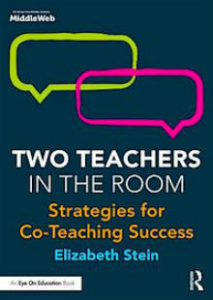Try a Bit Less Tech and a Bit More Listening
A MiddleWeb Blog
 I was recently speaking with some middle school students who shared their take on what learning is like this school year.
I was recently speaking with some middle school students who shared their take on what learning is like this school year.
I was not surprised to hear that technology was a major theme in their responses. Most are enjoying the increased technology applications.
But it was the response of one student that really got me thinking. He shared his wish for school to be “like it used to be.” After gentle nudging on my part, he expanded.
“Well, it’s like we just have to do our work on the computer. It’s great, but it’s like technology just takes over.”
The next few seconds for me were in slow motion. I heard the student’s voice echoing in my mind…it just takes over…it just takes over…it just takes over…. He really struck a chord for me.
Clearly this “takeover” isn’t the case in all classrooms. And it may not even be the case in this student’s classrooms. Yet, it is how he feels. It is his perception. And he, like everyone else, misses the familiar process of learning with everyone together in one classroom space.
Teachers all over the world are finding ways of connecting with students who are in multiple locations. Teachers are working so hard to find a balance between teaching, learning, and connecting with their students in ways that guide their meaningful participation.
What more could we possibly do? I thought about the critical need to make sure we bring in intentional humanizing practices to balance the necessary and helpful use of technology.
One of these practices is implementing and encouraging active listening. It is a skill that can take students in any classroom—remote, in-person, hybrid or otherwise—into those humanizing spaces that may motivate them to be a part of the learning process.
And if you’re lucky enough to have two teachers in the room, the active listening process just got even better.
Connecting with Students through Active Listening
Paraphrase: Co-teachers can model a short active listening scenario. One speaks. The other listens and then paraphrases the key point the speaker said. And don’t forget to model the nonverbal cues that further deepen the communication connection. Embed these moments throughout each day. Increasing the amount of time students spend paraphrasing keeps them on point, improves recall accuracy, and also offers another good reason to stay connected with the learning process.
Question: Rejuvenate any lesson with varied types of questions to spark, validate, and challenge students’ thinking. Here’s a refresher for the types of questions. When questions are varied, they have a better chance of piquing students’ curiosity and participation. Take it a step further and have students generate the questions. Check out these tips and/or these tips (both via Edutopia), and be ready to ramp up the active listening and participation as discussions in class unfold.
Stop and Jot: Embed time to have students jot down key information. It could be a shared Google Doc to increase student collaboration—or it could be individual note-taking followed by students sharing what they thought was key. Check out these note-taking strategies that can work for any grade or content area.
Whether students are remote or in person, there is always a way to engage in active listening and model that you care about what they are thinking. Offering interesting ways to express their thoughts increases the chances that they will provide you with opportunities to listen to them!
By creating the space and time for students to engage in active listening and meaningful conversation, you increase the chances that they will feel school is “more like it used to be.” Pause from time to time and let the human connection “take over” rather than any of the amazing and necessary technology tools we are all so grateful to be using.
How are you balancing the use of technology with the ways you are connecting with your co-teacher and your students?



































